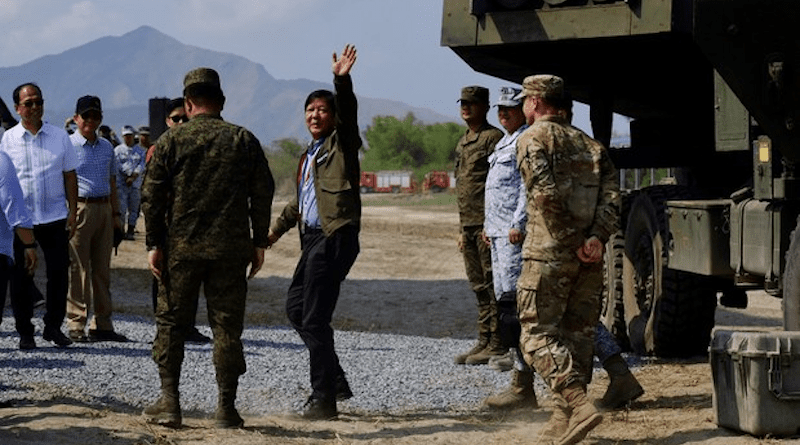China’s Strong-Arming Won’t Work In Marcos’ Philippines – Analysis
By Jenny Balboa and Shinji Takenaka
Despite careful words from Philippine officials, the latest US–Philippines Balikatan military exercise was a response to China’s increasing assertiveness in the South China Sea. China’s provocations had become indiscriminate — targeting both uniformed Filipino personnel and small-scale fisherfolk in the Philippines’ exclusive economic zone. China’s aggressive actions had become bolder, making it more difficult to turn a blind eye to the situation.
The 38th Balikatan exercise in April 2023 was the biggest in the three-decade history of their joint combat drills. The exercise did not sit well with Beijing, which immediately released a warning that such activities can aggravate tension in the area. The Chinese ambassador to the Philippines issued an upfront reproach to the Philippine government about China’s displeasure of such ‘provocative’ activities.
The United States and the Philippines promptly conducted the third 2+2 Ministerial Dialogue on 11 April 2023 in Washington. Top US–Philippines foreign affairs and defence officials issued clear-cut statements about the South China Sea conflict. The joint statement condemned China’s illegal activities and called for compliance with the 2016 Permanent Court of Arbitration decision, which rejected Beijing’s claims on territory and maritime rights based on its ‘nine-dash line’. The statement also reiterated the importance of maintaining peace and stability in the Taiwan Strait.
Under President Ferdinand Marcos Jr, the Philippines seems to have turned its back on the China appeasement strategy that characterised the foreign policy of his predecessor. Former president Rodrigo Duterte moved the Philippines closer to China by downplaying the Arbitral Tribunal award favouring the Philippines. In retrospect, Duterte provided China with ample space to construct a closer and mutually beneficial relationship with the Philippines.
Yet Beijing continued to conduct aggressive actions in the Philippines’ exclusive economic zone targeting the Philippine military and fisherfolk who are more disadvantaged. There was a clear mismatch between Beijing’s words and actions. It did not help that China reneged on many of its economic commitments to Manila. Beijing failed to fulfil its pledged investment in several big-ticket infrastructure projects.
As a dominant state that wields considerable influence in the economy and security of many countries, China seems to have assumed that vulnerable states, such as the Philippines, would tolerate its belligerent actions. China had lost sight that the Philippines — like many ASEAN countries — is a post-colonial state, sensitive to the raw ambition of superpowers to dominate and bend them against their will. Beijing overlooked the determinationof many domestic actors in these countries to defend their national interest.
The country’s territorial integrity is now under threat from a hegemonic China. Given the Philippine military’s inability to defend the country against a preponderant China, the Philippines moved closer to the United States, which provides the training and capacity to protect its territory.
The Philippines’ is also vital to US interests because it is a treaty ally that occupies a critical position in the US defence perimeter in Asia — the US alliance architecture which runs from East Asia to the South China Sea and the Western Pacific. During their meeting on 1 May, US President Joe Biden assured Marcos Jr that: ‘The United States remains ironclad in [its] commitment to the defence of the Philippines, including the South China Sea’.
A stronger Philippines–US alliance has complicated the cost for China to challenge the Philippines over territorial issues. Given the US military’s sophisticated weapons, equipment, and combat training, it is fully capable of deterring China’s advance in the South China Sea. The enlarged presence of the US military in the northern Philippines can also reinforce more dynamic and collaborative operations in case China attempts to forcefully unify Taiwan with the mainland.
The way China treated the Philippines in the 2010s showed Beijing’s overconfidence as a new global power. During the term of former president Benigno Aquino Jr — when the Philippines filed a case against China in 2013 at the Hague — China refused to participate in the three-year trial. Instead, Beijing continued to flex through military drills and issuing trade sanctions to the Philippines. Beijing lost a critical opportunity to prove that it respects the rule of law. During Duterte’s presidential term, Beijing wasted the chance to establish that it is a credible and benign great power to its neighbours.
Beijing left Manila with little choice but to take the next best approach, which was to strengthen its alliance with the United States to balance the China threat. This is not to say that the China–Philippines relationship is hopeless. China can take the time to review its foreign policy and learn from the unexpected consequences of its actions. The strong-arm policy that Beijing used on Manila only aggravates tensions and has proven to be unsustainable in the context of great power competition for influence in Asia.
But Manila can take advantage of warmer US–Philippines ties to address critical issues beyond the security realm. The Philippines can join like-minded countries to address its vulnerabilities — including Chinese trade dependence and other economic security and resilience issues.
About the authors:
- Jenny Balboa is a Lecturer at the Tokyo University of Foreign Studies and at the Department of Global and Interdisciplinary Studies, Hosei University.
- Shinji Takenaka is a Senior Economist at the Japan Center for Economic Research.
Source: This article was published by East Asia Forum

